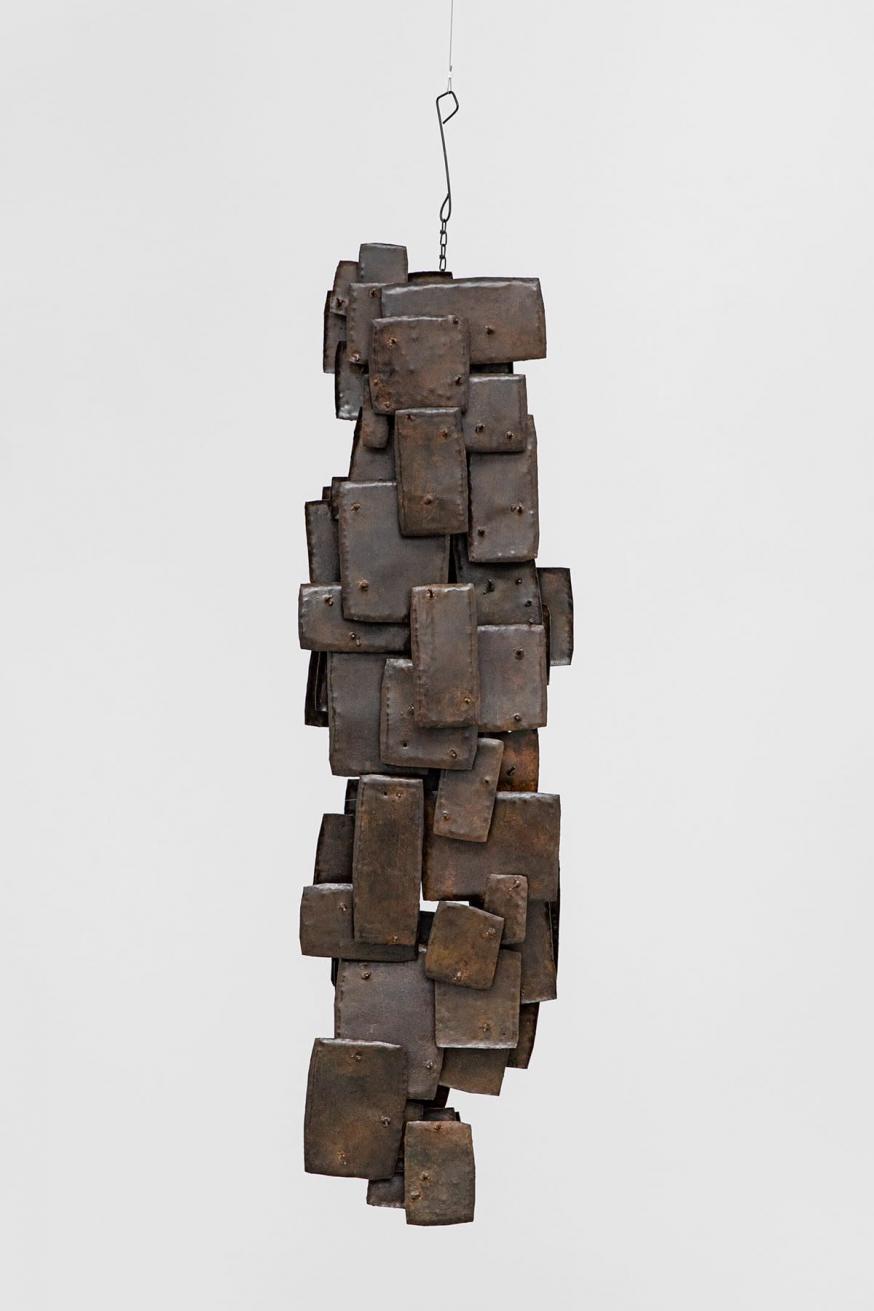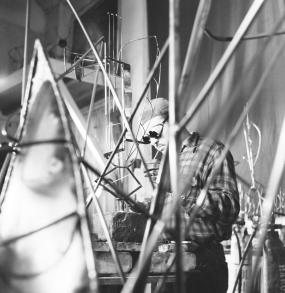Harold Cousins
1916–1992


Harold Cousins working in his studio in Paris, France, c.1952; Photographer unknown, Photographs of Marshall Plan Programs, Exhibits, and Personnel, 1948–67, National Archives and Records Administration, College Park, MD
All artworks displayed above are currently available. To inquire about additional works available by this artist, please contact the gallery.
Biography
…[O]ne might say that art, like science, is a constant probing of the unknown – a seeking. I believe an artist should make art that he feels relevant to his day, taking into account the works of artists of the past. The empty spaces within and around a sculpture post a challenge that has become for me almost an obsession.
A quintessential modernist sculptor known for his innovations in direct metal techniques, Harold Cousins (1916–1992) was born and raised in Washington, DC. Cousins’ early exposure to art came about through his experiences in the cultural hub known as “Black Broadway,” in the District’s U-Street neighborhood. The area’s vibrant musical and artistic scene provided some insulation from the rest of the nation’s racism during Cousins’ early years and allowed him to develop ambitions for an art career. After high school he attended Howard University, where he majored in Psychology and Sociology. At Howard, Cousins was taught and influenced by Dr. Ralph Bunche (1904–1971)—an American political scientist who would become the first Black American appointed U.S. ambassador to the United Nations—and Dr. Alain Locke (1885–1954), influential writer and theorist, then head of the Philosophy department. Locke inspired Cousins’ initial interest in African art, and they maintained a friendship for many years. In the late 1930s and early 1940s, he took his first art studio art classes at local schools while working for the US Post Office. From 1943 to 1945 Cousins served as a sonarman in the Coast Guard, returning to Washington, DC in 1946 to resume his job as a postal employee and continue his sculpture classes.
In 1948, Cousins moved to New York City and enrolled at the Art Students League. There he met his future wife, Peggy Thomas, who was also studying sculpture, and developed friendships with Michael Goldberg, William Stanley Hayter and Frank Stella while studying under sculptor William Zorach and painter Will Barnett. In 1949, with funding from the GI Bill, the couple relocated to Paris, where Cousins was one of ten students accepted to study privately in the Montparnasse studio of Russian Cubist-Expressionist sculptor Ossip Zadkine (1890–1967).
Cousins was captivated by the museums in Paris and frequented the Louvre—especially its Egyptian wing—the Musée Rodin, and the city’s many ethnographic museums, especially the Musée de l’Homme, where he discovered the sculptural traditions of Africa, Asia and the Americas. Cousins was particularly attracted to the masterful woodworking of the African masks as well as the works that combined wood with other materials such as metal—something Cousins had begun to explore in his own work. As he explained, “What especially attracted me was the use of sheaths of metal, often together with nails and chains. These sculptures have a vibrancy that seems to be produced both between the metal elements themselves and between the metal elements and the overall sculptural form.”[1]
A crucial turning point for the artist occurred in the early 1950s, when Cousins learned oxyacetylene welding from the American sculptor Shinkichi Tajiri (1923–2009), who was one of his classmates at Zadkine’s studio and had worked for Isamu Noguchi (1907–1988) before relocating to Paris. Cousins’ style began to move away from figurative forms in terracotta and wood to metalworks. Enthralled by this new technique, Cousins shared his interest in welding with Zadkine, who rejected the practice and suggested he study sculpture at the Académie de la Grande Chaumière. There Cousins joined a circle of fellow expatriate artists also enrolled at the school, which included Beauford Delaney, Ed Clark, Herbert Gentry and Larry Potter.
Cousins was deeply inspired by the work of sculptor Julio González (1876–1942) and, in 1952, he created his first welded steel direct metal sculpture with scrap bought from junkyards along the Seine. The artist stated that his initial forays into welding were born out of his fascination with “the ‘magic’ of joining together pieces of metal of different shapes.”[2] Cousins soon arrived at his mature style as a sculptor working in metal and, just two years later, Galerie Raymond Creuze mounted the first major exhibition of Cousins’ metal works. Some of the first forms that Cousins created were assemblages of vertically oriented welded steel rods, which he referred to as “forests.” While firmly rooted in abstraction, Cousins’ linear works from this period are often semi-representational, evoking such subjects as warriors, musicians and birds. Cousins designed these works as both reliefs and freestanding sculptures with the aim of activating the space surrounding them through the interplay of light and shadows cast by his forms. He referred to such experimentations as “drawings in space,” a concept he credited to González.
In 1957, Cousins coined the term plaiton—a synthesis of the English word “plate” and the French “laiton” (brass)—to describe his sculptures of repeated metal plates welded together in a predetermined order. In discussing these works, Cousins once stated that a key part of the process for him involved “giving special attention to the form of the empty space between the solid elements of a sculpture as well as to the empty space surrounding the sculpture.”[3] Cousins continued to work on these large-scale works for many years, extensively exploring their structural possibilities in both horizontal and vertical orientations, often joining the plaitons to rods. In addition to these artistic breakthroughs, the period was significant on a personal level as well: Cousins’ daughter Danielle was born in 1957, followed by his son Marc in 1959. In the early 1960s, the family acquired a home, known as Le Mont Herault, in the Normandy countryside, and Cousins’ immersion in a natural setting would have a profound effect on his work.
In 1950, Cousins had his first solo exhibition in Paris at Galerie Huit, an artist-run cooperative associated with Tajiri, Sam Francis, Sidney Geist, Al Held, Paul Jenkins, Jonah Kinigstein, Joan Mitchell, Jules Olitski and Haywood “Bill” Rivers, among others. Cousins participated in numerous prestigious exhibitions throughout the 1950s, including the annual presentations of the Salon de la Jeune Sculpture and the Salon des Réalités Nouvelles. During these years, he became acquainted with Karel Appel, César, Sonia Delaunay and Michel Seuphor, who also wrote about Cousins’ work. From 1960 until 1967, Cousins was represented by Galerie Karl Flinker while continuing to exhibit with Galerie Creuze alongside Antoni Tàpies, Oscar Chelimsky and other members of the École de Paris.
Throughout the 1950s and 60s, Cousins continued to develop his Plaiton sculptures—evoking the natural world as well as architecture—while beginning to experiment with a return to abstract figurations of the human form. Unlike his earlier work, these sculptures exhibit a clear political and social commentary, embodying a specific cultural identity as well as a universal statement on the human condition. Several sculptures, with such titles as Political Prisoner (1954) and Slave (1963), directly reference the civil rights movement in the United States that Cousins followed and reacted to from abroad. Working in solid, Cubist-style forms—which themselves referenced a Futurist-style sense of movement—Cousins’ works of the late 1970s evolved into his Human Comedy series comprising linear, puppet-like sculptures that pondered philosophical and existential questions. The artist explained that these figures came out of the “belief [that] everything we undertake is affected, even manipulated, by forces outside our own control.”[4]
Cousins moved to Brussels, Belgium in 1967, where he lived and worked for the remainder of his life. There, he was represented by Galerie Carrefour, which mounted several solo exhibitions of his work. In 1975 and 1976, Cousins’ first retrospectives were mounted at La Maison des Arts in Schaerbeek and the Cultural Center of Woluwe-Saint-Pierre, respectively. Throughout his career, he was celebrated in Europe, completing numerous public and private commissions, exhibiting frequently in Belgium, France and Germany. However, it was not until four years after his death that his work was shown in his native country; in 1996, nine works were included in The Studio Museum in Harlem’s traveling exhibition, Explorations in the City of Light: African-American Artists in Paris, 1945-65.
Michael Rosenfeld Gallery’s representation of the Estate of Harold Cousins represents a culmination of the commitment and dedication to Harold Cousins’ work and legacy that spans more than two decades. In 1999, the gallery mounted a solo exhibition of the artist’s work: Harold Cousins, The 1950s: Welded Sculpture. The gallery has also included his work in several group exhibitions, including the celebrated series African American Art: 20th Century Masterworks (1998, 1999, 2000); Linear Impulse (1999); Decoding Myth: African American Abstraction, 1945-1970 (2007); African American Art: 200 Years (2008); Abstract Expressionism: Further Evidence (Part Two: Sculpture) (2009); Abstract Expressionism: Reloading the Canon (2011); Beyond the Spectrum: Abstraction in African American Art, 1950-1975 (2014); METAL: American Sculpture, 1945-1970 (2016) and Globalism Pops BACK Into View: The Rise of Abstract Expressionism(2019). In 2023, Michael Rosenfeld Gallery presented the solo exhibition, Harold Cousins: Forms of Empty Space, the first solo exhibition of the artist’s work in the United States in fifteen years and the gallery’s first exhibition dedicated to Cousins since taking on representation of the artist’s estate in 2020.
In the past twenty years, Cousins’ work has been shown in such group exhibitions as Western Neolithic Idols: Symbols of Fertility and Life, Loyola University Museum of Art, Loyola University, Chicago, IL (2009); Artists in Exile: Expressions of Loss and Hope, Yale University Art Gallery, Yale University, New Haven, CT (2017); Picasso to Pollock: Modern Masterworks from The Eskenazi Museum of Art at Indiana University, Speed Art Museum, Louisville, KY (2019); and Riffs and Relations: African American Artists and the European Modernist Tradition, The Phillips Collection, Washington, DC (2020). In 2024, Cousins’ sculpture La Forêt (c.1960) was featured in the acclaimed exhibition Americans in Paris: Artists Working in Postwar France, 1946-1962 at New York University’s Grey Art Museum, New York, NY, traveling to the Addison Gallery of American Art in Andover, MA later that year.
Harold Cousins’ work can be found in museum collections worldwide including the Bibliotheque Royale, Brussels, Belgium; Birmingham Museum of Art, Birmingham, AL; Centre National d’Art Contemporain, Paris, France; Cogi France, Paris, France; Etat Belge, Nederland Culture, Belgium; Howard University Gallery of Art, Washington, DC; Lehmbruck Museum, Duisburg, Germany; Maison de la Culture, Wolusé-st-Pierre, Belgium; The Metropolitan Museum of Art, New York, NY; Middleheim Museum, Brussels, Belgium; Middleheim Museum, Antwerp, Belgium; Modern Art Museum, Brussels, Belgium; Modern Museum of Art, Kassel, Germany; Musée d’Art Moderne, Paris, France; Musée de St. Etienne, Paris, France; Museum Haus Lange, Germany; Sidney and Lois Eskenazi Museum of Art at Indiana University; and the Yale University Art Gallery, New Haven, CT.
Michael Rosenfeld Gallery LLC is the exclusive representative of the Estate of Harold Cousins.
[1] Harold Cousins, “‘Plaiton’ Sculpture: Its Origin and Developments,” Leonardo vol. 4, no. 4, Fall 1971, 351.
[2] Ibid, 352.
[3] Ibid.
[4] Cousins, quoted in Rona Dobson, “La comédie humaine d’Harold Cousins,” Harold Cousins: La Comédie Humaine (Brussels: Galerie Rencontre, c.1977), n.p.
Gallery Exhibitions
Press

